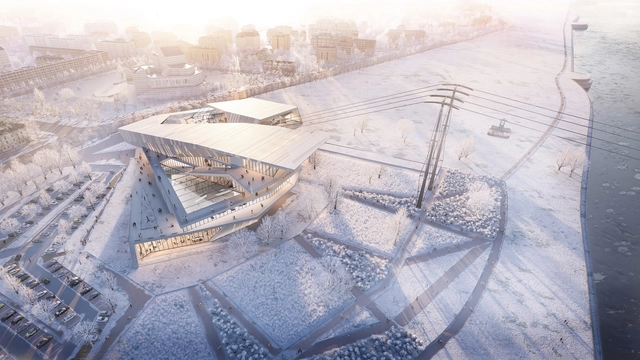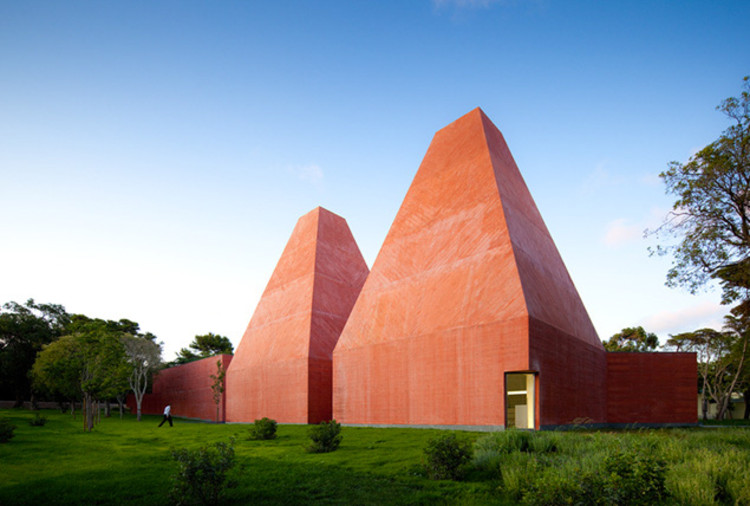Two design professors have designed and built a set of fluorescent pink seesaws along the US-Mexico border, seeking to evoke a concept of unity and play between the two sides. As reported by The Guardian, the set was installed along the steel border fence on the outskirts of El Paso, Texas, and Ciudad Juárez, Mexico.
Architecture News
Monograph Compiles Data-Driven Starchitect Ranking

Monograph recently released a data-driven starchitect ranking to show how popular famous architects are. Created by digital product designer Moe Amaya and Monograph's data team, the project utilizes the STAR system ranking algorithm to determine the relative popularity and value of an architect's brand.
Gensler Unveils Temporary Worship Pavilion for Notre Dame

Architecture firm Gensler has unveiled a design for a temporary worship pavilion at Notre-Dame Cathedral in Paris. Set to be located in Parvis Square, the temporary structure would be constructed primarily out of charred timber for added strength and durability. The proposal comes after the Notre Dame fire in April this year. The Pavillon Notre-Dame was designed to offer hope to Parisians and international visitors while the 850-year-old cathedral is being restored.
Hopkins Architects Win the MK:U International Design Competition

MK:U International Design Competition announced today that the International team led by London based Hopkins Architects was selected unanimously by the jurors, as the winner of their new model university competition launched in early 2019.
MK:U is one of many big projects planned for Milton Keynes’s near future, in order to develop the economy of the city, to reach new competitive heights. The university is a partnership between MKC and Cranfield University. Designed to meet the needs of the digital age, it basically equips students for the 21st-century workplace, and for future careers in emerging fields.
ArchDaily & Strelka Award: Last Day to Vote and Decide the Finalists

ArchDaily, Strelka Institute, and Strelka KB have selected a long list of 50 architectural projects from Armenia, Belarus, Estonia, Georgia, Lithuania, Moldova, Russia, Ukraine, and Uzbekistan. The open call invited emerging architects to submit their built projects that emphasize sustainability, research-based and participatory design, and the innovative use of materials. Architects and architecture and design firms that started their practice no more than 10 years ago could apply with projects that were built in the past five years.
Until July 31, the readers of ArchDaily and Strelka Mag can vote for the projects that will make the shortlist.
Sasaki Designs a New Progressive Master Plan and Four New Buildings for the Universidad de Lima

The Universidad de Lima, the most influential institution in Peru, is expanding its campus, in the heart of the capital, to offer a new learning experience, a never seen before novelty amongst the schools in Latin America.
The project’s main purpose is to create the whole college town, usually found abroad, in its central location in Lima. This innovative approach comes from the understanding of the importance of the concept of “university-cities” as a key economic driver. In fact, the master plan suggests making the campus as inclusive as possible, by putting in place all the facilities needed for students to actually linger.
Teamakers Guest House Competition Results Announced

Bee Breeders has announced the winners of the Teamakers Guest House competition, calling for design proposals for an eco-friendly, cost-effective accommodation to house visitors to the Ozolini teamakers retreat, situated in a forest 100 kilometers southeast of the Latvian capital of Riga.
bKL Designs Expressive UBTECH Headquarters in Shenzhen

bKL Architecture has released its design for the UBTECH Headquarters in Shenzhen, China. Seeking to harmonize technology and nature, the 212-meter-high scheme features an expressive structure and mass, and vast, expansive sky gardens. The expressive gardens allow for all floors of the mixed-use office building to host an interactive experience with nature.
AECOM Reveals Basketball Net-Inspired Arena for Los Angeles

AECOM has unveiled a new design for a "basketball net-inspired" 900,000-square-foot arena for the LA Clippers in Inglewood. Working with Anderson Barker Architects, the City Design Studio of Los Angeles, and Hood Studios, the team's proposal includes a solar panel tile cladding system around the building and sunken basketball court. The project's facade was designed to symbolize the diamond shapes in a basketball net.
Herzog & de Meuron Propose New Urban Plan for the West of Munich

Herzog & De Meuron presented this week to the public their new vision for the cityscape and the urban life of Munich. The plan revolves around a former postal railway hub, the Paketposthalle, an impressive concrete structure built in the 60’s, used lately as a sorting office for general mail. The 87,000 square meters site was recently acquired by Büschl, a private group of developers, who commissioned Herzog & de Meuron to create a new urban study for the area.
ASAP Creates "Large Rock" Hotel Tower for Downtown Los Angeles

Adam Sokol Architecture Practice (ASAP) have revealed the design for a hotel tower made to be a piece of urban geology in downtown Los Angeles. Called the Spring Street Hotel, the project is designed to capitalize on the accelerating growth and development of the downtown LA area. Situated in the core historic district of downtown, the tower aims to build on its distinctive location and cultural context to create a landmark destination for the city.
Spotlight: Santiago Calatrava

Known for his daring neo-futurist sculptural buildings and over 50 bridges worldwide, Santiago Calatrava (born July 28, 1951) is one of the most celebrated and controversial architects working today. Trained as both an architect and structural engineer, Calatrava has been lauded throughout his career for his work that seems to defy physical laws and imbues a sense of motion into still objects.
Kengo Kuma Builds Upon Historic Facade in New Seattle Skyscraper

Kengo Kuma & Associates have proposed a new 40-story mixed-use skyscraper incorporating a historic Gothic Revival facade in Seattle. Located in the Belltown neighborhood, the project would reuse the ornate five-story Bebb & Gould’s Terminal Sales Annex facade. Made in collaboration with Ankrom Moisan Architects and the landscape architecture firm Berger Partnership, the project aims to reinforce the Gothic and Art Deco heritage of Seattle’s downtown.
Utrecht Creates 300 Bee-Friendly Bus Stops

The City of Utrecht Council, in collaboration with advertising agency Clear Channel, has transformed 316 bus stops across the city into “bee stops.” The adaption involved installing green roofs onto the bus stops, creating bee-friendly spaces for the endangered species.
RIBA Reveals Shortlist for Neave Brown Award for Housing

The Royal Institute of British Architects (RIBA) has revealed the shortlist for the first Neave Brown Award for Housing, named in honor of architect Neave Brown who passed away in January 2018. The four housing developments span London, Cambridge, and Norwich, and were all winners of a 2019 RIBA Regional Award.
Makr Shakr Opens Robotic Bars in Milan and London

Bar producer Makr Shakr has unveiled new rooftop robotic bars in Milan and London. Founded by MIT professor Carlo Ratti, the company's new projects are made to engage with the city and explore the potential of technology. In Milan, the project is the city's first robotic bar, while the London bar is on display at the Barbican as part of its AI: More than Human exhibition. Makr Shakr's bars aim to combine barman roots with food tech around the future of human-machine collaboration.
Andrés Jaque / Office for Political Innovation Unveil Experimental Madrid School

Andres Jacque / Office for Political Innovation has released their design for the Reggio School in Encinar de los Reyes, Madrid. Promoted by the Reggio Center for Pedagogical Research and Innovation, the project is based on the idea that architectural environments can evoke in children the desire for exploration and inquiry.
Spotlight: Eduardo Souto de Moura

Eduardo Souto de Moura (born 25 July 1952), the Portuguese architect that won the 2011 Pritzker Prize, is known for designs that are formally simple yet serious and at times, dramatic, created through his thoughtful use of colors and materials. His architecture is both versatile and consistent, contextual yet universal, and rarely affected by current trends or styles.
Honglin Li Designs Waste-to-Energy Skyscraper in Great Pacific Garbage Patch

Designer Honglin Li has created a proposal for a waste-to-energy skyscraper in the Great Pacific Garbage Patch. Called FILTRATION, the project was awarded Honorable Mention in the 2019 eVolo Skyscraper Competition. The modular, prefabricated megastructure contains several Material Recovery Facilities and Water Treatment Plants to recycle the floating garbage and clean seawater while taking on the world energy crisis.
ArchDaily & Strelka Award: Vote Now to Decide the Winners

ArchDaily, Strelka Institute, and Strelka KB have selected a long list of 50 architectural projects nominated for the joint ArchDaily & Strelka Award, which celebrates emerging architects and new ideas that transform the contemporary city. Now the readers of ArchDaily and Strelka Mag can vote for their favorite project to decide the finalists.
Cutaway America: Discover 8 United States Landmarks in Cross-Section

American home services website Angie's List has released a series of commissioned images showcasing eight United States landmarks in cross-section. Dubbed Cutaway America, the project takes a new perspective on projects that people are used to seeing from the outside. From idealistic designs that attempt to become one with nature to complex infrastructure, these cutaways hint at a longer story of America and its history.





























.jpg?1564082996)
.jpg?1564082938)








